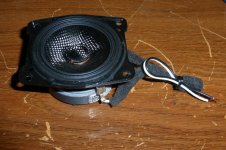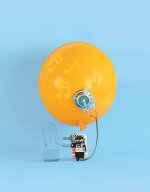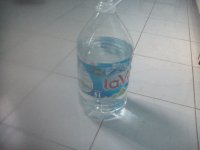Trying to save space here. I'm deciding what kind of enclosure to use for some Sony 1-859-076-21 magnetic fluid speakers. I cannot find any specs for this driver, so I used specs from a similar sized one to calculate a sealed enclosure volume and resonant frequency. Vas = 0.02 ft^3, Fs = 113 Hz, Qts = 0.44
Qtc Vb (L) F3 Fb
0.707 0.36 182 182
0.6 0.66 186 154
0.5 1.94 200 128
Those sizes are a little big for my taste. I was thinking what if you use a plastic bag or balloon instead. They would only be 1/2 filled, and ideally, the slightest pressure will change their shape, creating no resistance on the speaker. It seems this could be hard to pull off since such a thin bag will transmit sound. And if you make it thicker, it will put as much resistance on the speaker as a rigid enclosure?
Qtc Vb (L) F3 Fb
0.707 0.36 182 182
0.6 0.66 186 154
0.5 1.94 200 128
Those sizes are a little big for my taste. I was thinking what if you use a plastic bag or balloon instead. They would only be 1/2 filled, and ideally, the slightest pressure will change their shape, creating no resistance on the speaker. It seems this could be hard to pull off since such a thin bag will transmit sound. And if you make it thicker, it will put as much resistance on the speaker as a rigid enclosure?
Attachments
Your method of calculating appropriate size will only be right with very small probability. Sealed, once big enuff is pretty tolerant of size thou.
Are you suggestting substituting a balloon for a box? It won’t work.
dave
Are you suggestting substituting a balloon for a box? It won’t work.
dave
Yes, I'm asking if a balloon can approximate an infinite sealed enclosure, but at a much smaller size. Can you elaborate why it won't work?
Another thing I thinking is since Sony is claiming these use 35% less energy, does that mean the Qts is low so I can use a small enclosure without raising the resonant frequency too much?
Another thing I thinking is since Sony is claiming these use 35% less energy, does that mean the Qts is low so I can use a small enclosure without raising the resonant frequency too much?
Putting a driver in a plastic bag is not much different than just using it naked. It does nothing as far as being a box goes.
dave
dave
Haha, that's what I thought. But what if you put a 2nd bag outside the 1st and will that with Helium. That's a 100x sound reduction according to this guy, regardless of the thickness Helium the World's Best Sound Suppressor - YouTube
I'm not an expert in speaker design, but from what I do understand, you're trying to set up a tuned suspension system using the driver and the compliance of the air within the sealed box. The problem with your balloon box is not that the sound escapes, it's that the walls of the "box" stretch. That changes the suspension. If you've ever driven a car with bad shocks, you're familiar with how "well" that works. I doubt it would work any differently in the acoustic domain.
0.36 litre is the size of a (12-oz) beer can. Is that really too much?
Tom
0.36 litre is the size of a (12-oz) beer can. Is that really too much?
Tom
Cerwin-Vega's S1 used an inert gas filled bag (SF6 - Sulfer Hexafloride) in hopes to reduce cabinet size. Furthermore S1 was a 6th order reflex which is ideal for LF extension in a small package using a narrow width Q-2 boost at Fb with excursion cut below the useful range. Qts=0.312 is optimal. Without the boost, the alignment is SBB4, considered to have the best transient response of the reflex alignments.
The speed of sound in SF6 is 135 m/s vs 340 m/s in air. That's probably how they could make the box smaller. If you want to make the box larger, fill it with helium (1 km/s).
Tom
Tom
Cerwin Vega madea S1,and S2 that had gas bags to affect the drivers, but they still had to use a cabinet. If you do not want a box...I would suggest a OB setup.
OK, looks like everyone thinks a simple bag is a dumb idea. But using multiple bags filled with different gasses seems promising.
Never heard about Cerwin-Vega S1. But that bag is still inside a sealed box I presume, to prevent the gas from leaking. That will resist the bag expanding or contracting. So that's still a sealed enclosure and not the same as the ideal, 0 resistance bag I'm thinking of.
layering helium with SF6 to further reduce transmission by impedance mismatch
I guess I am a little greedy (aiming for Qts 0.6 which would need 0.66 L). I want to use these as computer speakers that will clip to the sides of a monitor to not take up and desk space. Also, the walls "stretching" shouldn't matter. I said ideally, it will stretch or contract so easily that it's an infinite baffle.0.36 litre is the size of a (12-oz) beer can. Is that really to much?
Never heard about Cerwin-Vega S1. But that bag is still inside a sealed box I presume, to prevent the gas from leaking. That will resist the bag expanding or contracting. So that's still a sealed enclosure and not the same as the ideal, 0 resistance bag I'm thinking of.
Hmm, I don't know how to explain that contradiction, but TechIngredients said helium transmits less sound because the molecules weigh 1/8 that of air, Helium the World's Best Sound Suppressor - YouTube. Also it was suggested @ 17:42If you want to make the box larger, fill it with helium (1 km/s)
layering helium with SF6 to further reduce transmission by impedance mismatch
You can use a bag or balloon if its walls are made of at least 1mm thick fiberglass or carbon fiber composite.
A perfect ball shape is strongest, any flat surface is way weaker.
Sorry, any wall flexibility is counter productive.
A perfect ball shape is strongest, any flat surface is way weaker.
Sorry, any wall flexibility is counter productive.
- had a pair of S1 in the early 1980's , as mentioned before, 6th order reflex with line level ~Q=2 peaking box. (the slot vent was on the rear of the box) .They weren't the most neutral speaker but would play quite loud without strain with a DH200 Hafler. - love to do a knockoff but might have to do 15/8/ horn
never saw the S2 other than brochures.
never saw the S2 other than brochures.
How about plastic jar as shown bellow. The speaker mounted on a wooden crown screwed upon the plastic jar, the cylindrical plastic acts as passive radiator. By painting layers of liquid rubber , used to waterproof decks of building, the resonant frequency can be adjusted. for damping, use a 5cm wide band of linen canvas or denim "jeans" clothe cut in diagonal fibers, impregnated by liquid rubber and glued around the jar.
If installed in room corner, it can deliver very clean bass. see similar type here
corner Chambord with passive radiating sphere
If installed in room corner, it can deliver very clean bass. see similar type here
corner Chambord with passive radiating sphere
Attachments
Last edited:
I read something about a balloon or a flexible bag, partly filled with a liquid with athmospheric vapor prrssure at room temp, this would be very compressible and have the effect of making the volume of the box seem larger.
I guess I am a little greedy (aiming for Qts 0.6 which would need 0.66 L). I want to use these as computer speakers that will clip to the sides of a monitor to not take up and desk space. Also, the walls "stretching" shouldn't matter. I said ideally, it will stretch or contract so easily that it's an infinite baffle.
Hmm, I don't know how to explain that contradiction........
Change the density/type of gas changes the box compliance, changing the driver's response and tuning [Fb], hence box Q.
FWIW, use to [tightly] wrap the driver frame with duct tape or similar to make it a sealed back for sealed mids, wide range tweeters, compression horn drivers, punching sufficiently small holes in it as required to ~aperiodically tune it if needing to lower its Q, Fb, so might want to try it since it's easy/cheap/reversible.
GM
- Home
- Loudspeakers
- Full Range
- Using a balloon or plastic bag as a speaker enclosure to reduce size?


